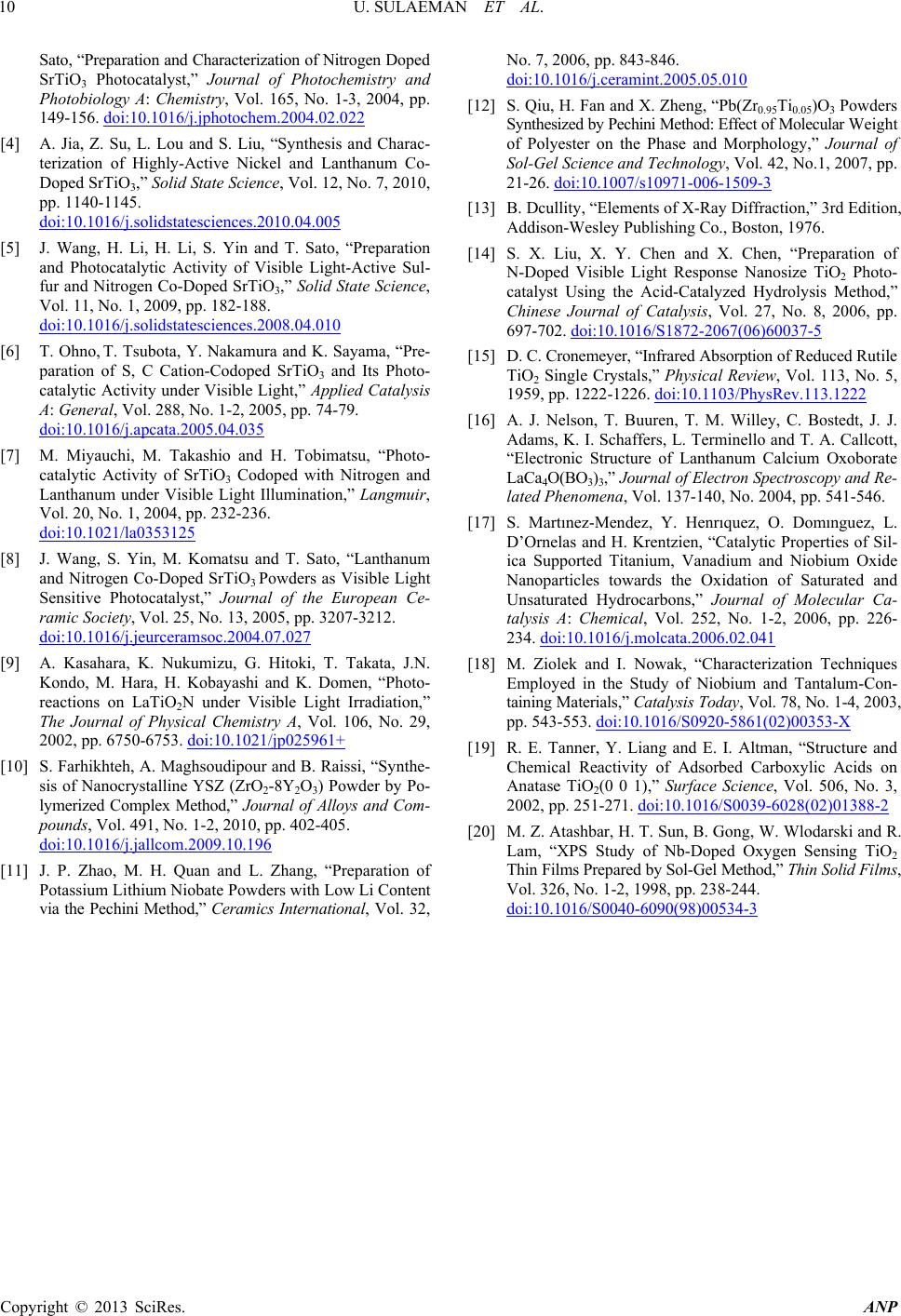
U. SULAEMAN ET AL.
10
Sato, “Preparation and Characterization of Nitrogen Doped
SrTiO3 Photocatalyst,” Journal of Photochemistry and
Photobiology A: Chemistry, Vol. 165, No. 1-3, 2004, pp.
149-156. doi:10.1016/j.jphotochem.2004.02.022
[4] A. Jia, Z. Su, L. Lou and S. Liu, “Synthesis and Charac-
terization of Highly-Active Nickel and Lanthanum Co-
Doped SrTiO3,” Solid State Science, Vol. 12, No. 7, 2010,
pp. 1140-1145.
doi:10.1016/j.solidstatesciences.2010.04.005
[5] J. Wang, H. Li, H. Li, S. Yin and T. Sato, “Preparation
and Photocatalytic Activity of Visible Light-Active Sul-
fur and Nitrogen Co-Doped SrTiO3,” Solid State Science,
Vol. 11, No. 1, 2009, pp. 182-188.
doi:10.1016/j.solidstatesciences.2008.04.010
[6] T. Ohno, T. Tsubota, Y. Nakamura and K. Sayama, “Pre-
paration of S, C Cation-Codoped SrTiO3 and Its Photo-
catalytic Activity under Visible Light,” Applied Catalysis
A: General, Vol. 288, No. 1-2, 2005, pp. 74-79.
doi:10.1016/j.apcata.2005.04.035
[7] M. Miyauchi, M. Takashio and H. Tobimatsu, “Photo-
catalytic Activity of SrTiO3 Codoped with Nitrogen and
Lanthanum under Visible Light Illumination,” Langmuir,
Vol. 20, No. 1, 2004, pp. 232-236.
doi:10.1021/la0353125
[8] J. Wang, S. Yin, M. Komatsu and T. Sato, “Lanthanum
and Nitrogen Co-Doped SrTiO3 Powders as Visible Light
Sensitive Photocatalyst,” Journal of the European Ce-
ramic Society, Vol. 25, No. 13, 2005, pp. 3207-3212.
doi:10.1016/j.jeurceramsoc.2004.07.027
[9] A. Kasahara, K. Nukumizu, G. Hitoki, T. Takata, J.N.
Kondo, M. Hara, H. Kobayashi and K. Domen, “Photo-
reactions on LaTiO2N under Visible Light Irradiation,”
The Journal of Physical Chemistry A, Vol. 106, No. 29,
2002, pp. 6750-6753. doi:10.1021/jp025961+
[10] S. Farhikhteh, A. Maghsoudipour and B. Raissi, “Synthe-
sis of Nanocrystalline YSZ (ZrO2-8Y2O3) Powder by Po-
lymerized Complex Method,” Journal of Alloys and Com-
pounds, Vol. 491, No. 1-2, 2010, pp. 402-405.
doi:10.1016/j.jallcom.2009.10.196
[11] J. P. Zhao, M. H. Quan and L. Zhang, “Preparation of
Potassium Lithium Niobate Powders with Low Li Content
via the Pechini Method,” Ceramics International, Vol. 32,
No. 7, 2006, pp. 843-846.
doi:10.1016/j.ceramint.2005.05.010
[12] S. Qiu, H. Fan and X. Zheng, “Pb(Zr0.95Ti0.05)O3 Powders
Synthesized by Pechini Method: Effect of Molecular Weight
of Polyester on the Phase and Morphology,” Journal of
Sol-Gel Science and Technology, Vol. 42, No.1, 2007, pp.
21-26. doi:10.1007/s10971-006-1509-3
[13] B. Dcullity, “Elements of X-Ray Diffraction,” 3rd Edition,
Addison-Wesley Publishing Co., Boston, 1976.
[14] S. X. Liu, X. Y. Chen and X. Chen, “Preparation of
N-Doped Visible Light Response Nanosize TiO2 Photo-
catalyst Using the Acid-Catalyzed Hydrolysis Method,”
Chinese Journal of Catalysis, Vol. 27, No. 8, 2006, pp.
697-702. doi:10.1016/S1872-2067(06)60037-5
[15] D. C. Cronemeyer, “Infrared Absorption of Reduced Rutile
TiO2 Single Crystals,” Physical Review, Vol. 113, No. 5,
1959, pp. 1222-1226. doi:10.1103/PhysRev.113.1222
[16] A. J. Nelson, T. Buuren, T. M. Willey, C. Bostedt, J. J.
Adams, K. I. Schaffers, L. Terminello and T. A. Callcott,
“Electronic Structure of Lanthanum Calcium Oxoborate
LaCa4O(BO3)3,” Journal of Electron Spectroscopy and Re-
lated Phenomena, Vol. 137-140, No. 2004, pp. 541-546.
[17] S. Martınez-Mendez, Y. Henrıquez, O. Domınguez, L.
D’Ornelas and H. Krentzien, “Catalytic Properties of Sil-
ica Supported Titanium, Vanadium and Niobium Oxide
Nanoparticles towards the Oxidation of Saturated and
Unsaturated Hydrocarbons,” Journal of Molecular Ca-
talysis A: Chemical, Vol. 252, No. 1-2, 2006, pp. 226-
234. doi:10.1016/j.molcata.2006.02.041
[18] M. Ziolek and I. Nowak, “Characterization Techniques
Employed in the Study of Niobium and Tantalum-Con-
taining Materials,” Catalysis Today, Vol. 78, No. 1-4, 2003,
pp. 543-553. doi:10.1016/S0920-5861(02)00353-X
[19] R. E. Tanner, Y. Liang and E. I. Altman, “Structure and
Chemical Reactivity of Adsorbed Carboxylic Acids on
Anatase TiO2(0 0 1),” Surface Science, Vol. 506, No. 3,
2002, pp. 251-271. doi:10.1016/S0039-6028(02)01388-2
[20] M. Z. Atashbar, H. T. Sun, B. Gong, W. Wlodarski and R.
Lam, “XPS Study of Nb-Doped Oxygen Sensing TiO2
Thin Films Prepared by Sol-Gel Method,” Thin Solid Films,
Vol. 326, No. 1-2, 1998, pp. 238-244.
doi:10.1016/S0040-6090(98)00534-3
Copyright © 2013 SciRes. ANP